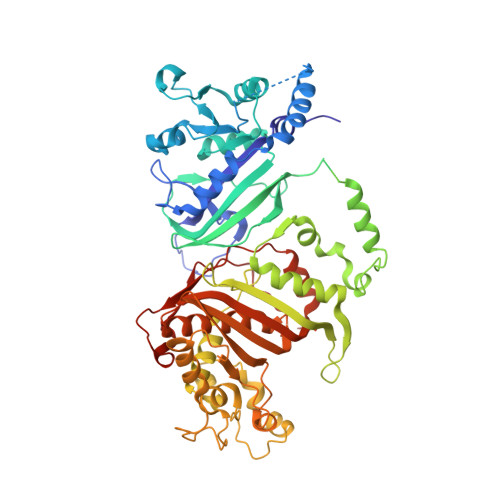Trypanosomal dihydrofolate reductase reveals natural antifolate resistance
Vanichtanankul, J., Taweechai, S., Yuvaniyama, J., Vilaivan, T., Chitnumsub, P., Kamchonwongpaisan, S., Yuthavong, Y.(2011) ACS Chem Biol 6: 905-911
- PubMed: 21650210
- DOI: https://doi.org/10.1021/cb200124r
- Primary Citation of Related Structures:
3QFX, 3QG2, 3QGT, 3RG9 - PubMed Abstract:
Dihydrofolate reductase (DHFR) is a potential drug target for Trypanosoma brucei, a human parasite, which is the causative agent for African sleeping sickness. No drug is available against this target, since none of the classical antifolates such as pyrimethamine (PYR), cycloguanil, or trimethoprim are effective as selective inhibitors of T. brucei DHFR (TbDHFR). In order to design effective drugs that target TbDHFR, co-crystal structures with bound antifolates were studied. On comparison with malarial Plasmodium falciparum DHFR (PfDHFR), the co-crystal structures of wild-type TbDHFR reveal greater structural similarities to a mutant PfDHFR causing antifolate resistance than the wild-type enzyme. TbDHFR imposes steric hindrance for rigid inhibitors like PYR around Thr86, which is equivalent to Ser108Asn of the malarial enzymes. In addition, a missing residue on TbDHFR active-site loop together with the presence of Ile51 widens its active site even further than the structural effect of Asn51Ile, which is observed in PfDHFR structures. The structural similarities are paralleled by the similarly poor affinities of the trypanosomal enzyme for rigid inhibitors. Mutations of TbDHFR at Thr86 resulted in 10-fold enhancement or 7-fold reduction in the rigid inhibitors affinities for Thr86Ser or Thr86Asn, respectively. The co-crystal structure of TbDHFR with a flexible antifolate WR99210 suggests that its greater affinity result from its ability to avoid such Thr86 clash and occupy the widened binding space similarly to what is observed in the PfDHFR structures. Natural resistance to antifolates of TbDHFR can therefore be explained, and potential antifolate chemotherapy of trypanosomiasis should be possible taking this into account.
Organizational Affiliation:
National Center for Genetic Engineering and Biotechnology, National Science and Technology Development Agency, Klong Luang, Pathumthani, Thailand.

















